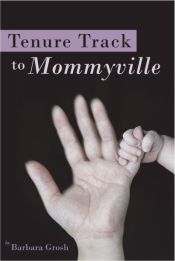buy the book at Lulu.com
discussion questions for book clubs
read Maureen Corrigan's speech at the award ceremony
read Anne Mulcahy's speech at the award ceremony
read Barbara Grosh's speech at the award ceremony
read the first chapter (pdf document)
Rochester Democrat & Chronicle coverage
Brighton-Pittsford Post coverage
Contact Barbara Grosh


Elaine Barlow has a bargain with her husband George: if she doesn’t find a new job by year’s end, he will choose their next move and re-establish his vet practice, which will probably spell the end of her career. Elaine used to be a high-flyer. She got her PhD, traveled all over Africa on a string of prestigious research fellowships, and landed a top-notch university teaching job. But she failed at the game of academic politics, she didn’t get tenure, and now she can’t seem to find another job. She’s lost her paycheck, her social status and her self-esteem. Stripped of her professional identity, Elaine lives a life of errands with her preschool daughter Stella. She listens to former colleagues being interviewed on NPR, while she has become invisible. Elaine studies the people she meets to see how they do it—how they live without tenure. She begins to imagine herself as something else. Lawyer? Teacher? Wildlife rehabilitator? Convenience store clerk? Long days with the spirited Stella leave Elaine feeling like a double failure. George stays out late several nights a week, supposedly working long hours at the job he hates. Can Elaine pull herself together before her marriage collapses too?
Finally, Elaine gets a chance at another academic job, but George refuses to relocate for it. He obviously has a secret, and Elaine fears the worst. But Elaine has been learning—from a manicurist, a flooring salesman, her former students, her parents, Stella, and their menagerie of special needs pets. She learns that it’s never too late to grow into a person you respect. And when that happens, anything is possible.
Xerox Aspiring Authors
Remarks by Anne Mulcahy, Chairman and CEO, Xerox Corporation
Chicago, September 13, 2005
Good morning and thank you, Maureen for your introduction. And thank you, Bob, for sharing your insights. There’s obviously a lot of passion for books in this room
I’ve been looking forward to this event because it brings together a cross-section of people in digital book publishing. Starting with the authors, of course, and the Web-based publishers, and the digital printers, the press and consultant community, and the creators of the enabling technology.
And here we are at the Harold Washington Library Center – a place built on books – and dedicated to the idea of equal access to information, ideas and knowledge. Just a few miles away, 80,000 people are at Print ’05 -- the nation’s largest printing exhibition -- where books and other digital applications are being produced in ways no one imagined a short time ago.
I think that’s really cool. And I’m delighted to be here.
Book publishing is close to Xerox’s heart. It’s also an industry in the midst of a dramatic transformation.
The number of new book titles doubled from 50,000 titles in 1985 to 100,000 in 1990. Then it doubled again – reaching 200,000 titles last year. The number of publishers doubled in the same time. (Frank Romano, PrintOnDemand.com, 3/3/05)
The people who track these things say a new book of fiction is published in the United States every 30 minutes! (R.R. Bowker, NYT)
Even with that explosive growth, hundreds of thousands of manuscripts go unpublished every year. (S&P Publishing Survey)
Surveys show 80 percent of us feel we have a book inside us – a story or an idea waiting to see the light of day. (Jenkins Group Study, 5/15/99)
So what’s driving all this pent up demand?
I think it has a lot to do with changing business models … changing technology … and changing market opportunities driven by trends like specialization and self-publishing.
Bob gave us some insights on the business of book publishing. Like every industry, the book industry is looking for new sources of growth in the face of everything from iPods and MP3 players to Tivo and streaming video.
Sixty percent of mass-market paperbacks and 40 percent of hard cover books are never sold. ( Werner Rebsamen, PrintOnDemand.com. 2/25/05 )
Mass production is no longer the only option. Mass customization is in vogue. Physical warehouses can be augmented with virtual databases. Old titles never need to go out of stock.
The lines between manufacturing, marketing and distribution are blurring. Amazon.com recently acquired its own on-demand digital book publishing operation.
Successful digital book manufacturers are running 24/7, with Web-based ordering, automated file preparation, printing and binding. Plus marketing and editing services.
What’s behind all these changes?
Emerging technology -- new digital systems, software and services that take Gutenberg’s original invention to a whole new level.
The start of the print on demand revolution can be traced back to the launch of the first digital system for book manufacturing, the Xerox DocuTech Production Publisher, in 1990.
We’ve come a long way since then – adding full-color digital color presses for producing color book covers and pages …
Automated book manufacturing workflow systems — from Web-based ordering to fulfillment and billing …
Finishing and binding systems …
And consulting services to help customers develop successful business models.
We did all this because there’s a huge market opportunity in books on demand.
We see more than 100 billion annual pages eligible for digital book manufacturing around the world.
And remember the 200,000 new book titles published last year? Frank Romano of Rochester Institute of Technology says 30 percent of them are printed in quantities of less than 100. And that could reach 50 percent by 2010.
Imagine that – half of all book titles produced in runs of less than 100 in the next five years!
Many of those titles will be driven by the growing trends toward specialization and personal publishing. In today’s world, where there’s a blog on every topic you can think of -- and a podcast and user group to go with it – books that target individuals and specialized communities of interest are a natural fit.
To that point, Xerox has been running a national television ad, promoting the capabilities of books on demand.
One of the thousands of authors inspired by the ad published a book called “The Viking Way of Winning – A Guide for Modern Managers.” It applies the management style of the Vikings to today's work world. The market was obviously too small for a traditional publisher, but the author is selling it to targeted audiences like The Viking Club of America and subscribers of Norwegian/American newspapers.
The world of self publishing is filled with great examples – and great stories – aimed at audiences small to large.
One of the reasons Xerox sponsored the Aspiring Authors contest was to recognize and encourage the people who put the DEMAND in print on demand – the authors.
Frankly, they don’t always get the recognition they deserve. But they are truly driving the new business models – and leveraging the new technology – that is creating a sea change in digital publishing.
In a recent article in the New York Times, Steve Riggio, the CEO of Barnes & Noble put it this way:
“Self publishing -- previously viewed as a last resort -- is increasingly seen as a first step.”
It’s hard to argue with that … especially when you consider the long list of famous self publishers – authors like Rudyard Kipling, D.H. Lawrence, Upton Sinclair, Gertrude Stein and Tom Peters – to name a few.
It is said that Mark Twain paid for the publication of The Adventures of Huckleberry Finn when he got tired of dealing with his previous publishers.
Dr. Suess’ first book was rejected 23 times.
Ironically, there’s a similar story with the technology that forms the core of today’s digital book systems.
Chester Carlson -- the inventor of xerography -- pounded the pavement for years in a fruitless search for someone to develop his invention into a useful product. He was turned down by more than 20 companies.
Finally in 1944, he struck a deal creating the company that became Xerox.
Chester Carlson’s idea helped democratize information.
That’s something we at Xerox hold very dear.
And that’s why we thought it was important to recognize the people who conceive the ideas … create the stories … and write the books produced with digital technology today.
More than 250 Aspiring Authors from across the country participated in the Xerox Aspiring Authors program.
We partnered with Lulu.com and ColorCentric to demonstrate the digital book publishing process from start to finish.
And each of the 250 authors who entered the contest received their manuscript back in the form of a complete, individually bound book.
So we really did publish for an audience of one.
The story lines were compelling …
A rollercoaster adventure that takes the reader from fire fights in the streets of New York to Navy SEAL units fighting their way to freedom.
A story of unlikely alliances -- set in the summer of 1963 – against the backdrop of a provincial town’s racial tensions.
Mystery … adventure … and, of course, romance.
The judging panel included noted book reviewers such as Maureen Corrigan along with experts from the academic and publishing worlds.
Three finalists were selected. Our runners up included:
“CodeName Snake: The Evil We Kill” by Morton Rumberg of Gold River California -- a full-blown thriller about an assassin operating in Nazi Germany.
And “The Long Black Veil” by sisters Jeannine Deline and Bobbi L’Huillier -- a carefully imagined and poignant melodrama about complicated relationships between compelling characters.
It was a tough field, and the winner – announced today and with us here -- is Barbara Grosh of Pittsford, New York, for “Tenure Track to Mommyville.”
It’s a great book that wrestles with the questions modern mothers face about the merits of professional work versus life spent with children.
The story tells the tale of Elaine Barlow, a professor who loses a political battle for tenure and returns home to a different kind of battleground – as she cares for her children and struggles to save her marriage.
Without giving away the ending, she learns it’s never too late to grow into a person you respect. And when that happens anything is possible.
Barbara has a Ph.D. in economics from the University of California at Berkeley. She is a freelance Web site developer …
the author and editor of numerous books and articles on African economic development …
and the winner of the 2005 Xerox Aspiring Authors contest!
Here to help me present a check for $5,000 and 100 copies of “Tenure Track to Mommyville” are friends Joy Eatman and Joanne Brundage with Mothers & More of Chicago. (Two walk in carrying a huge blow up of Barbara’s book with check attached to the cover)
So Barbara, please join me on stage to accept a rather large check – from Xerox and your supporters.
Thanks for sharing your ideas and thanks for being a leader in the on demand book publishing community.
(Barbara says a few words. Maureen wraps up the program. Lunch is served, followed by informal roundtable discussions at each table.)